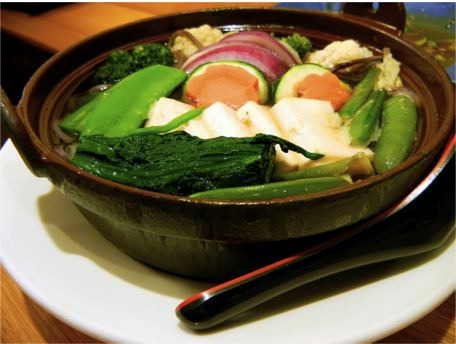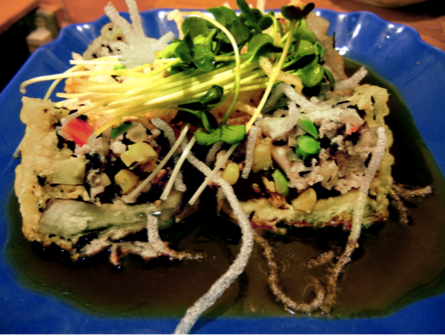savor
Mindful Eating, Mindful Life
savorthebook.com
Read More About
Mindful Eating
Mindful Living
Weight Loss
Exercise
Meditation
Delicious Vegan Japanese Food: Dining In & Out
The San Francisco Bay Area is known for its innovative, delicious, and healthy culinary options. Ingredients are always fresh—half of U.S.-grown fruits, nuts and vegetables come from California. Vegetarian and vegan options are especially abundant, making it an ideal place to eat a full-time, or part-time, plant-based diet.
Many of my favorite places to eat in the Bay Area are located in the city of Berkeley, which is famous for UC Berkeley, but also for its many restaurants and farmers markets. Cha-Ya, a fully vegan Japanese restaurant, is a neighborhood favorite (with a location in San Francisco as well). Before their expansion, it was rare to walk by without seeing a line. The menu is great for vegetable lovers, but also has options—such as tempura sushi rolls filled with avocado and yam—that are appealing to the masses.
The menu is quite extensive and can be overwhelming. My go-to items are the goma ae (blanched spinach served with a thick sesame dressing), agadashi tofu (best I’ve ever had), the Cha-Ya roll (tempura sushi roll mentioned previously), vegetable tempura soba noodle soup, and a simple avocado roll. These are consistently delicious, and most can be adapted to home cooking with a little bit of practice.
Recipes for goma ae, avocado sushi, vegetable tempura, and soba noodle soup are plentiful online. Preparing goma ae is fairly simple, but it may require buying a few ingredients that are less common in many households, such as sesame seeds, sake, tamari or soy sauce. Preparing vegetarian sushi rolls requires just a few ingredients (rice, seaweed, avocado, vinegar, sugar, salt, and maybe a rolling mat), but may take some practice to get the rolling technique just right.
Tips for making soba noodle soup with vegetable tempura at home:
The tempura should be served on the side of the soup so it does not get soggy. Soba noodles are less common than udon noodles in the US, but can be found in stores that sell health food or Asian products. Soba noodles are thin, brown noodles made from buckwheat. Not only are they tasty, they are easy to cook and typically made from whole grain buckwheat. They can be eaten with just about any kind of vegetable broth. Mushroom-based broth goes particularly well with soba. Vegetables that are compatible with the tempura-style include sweet potato, squashes, green beans, broccoli, sweet peppers, and carrots. Tempura batter can be made from scratch, but there are also mixes available at stores that sell Asian food. Just be sure to use healthy oil, such as canola oil for frying, and use safe frying techniques.
You may wish to replicate Cha-Ya’s artistry, as well as their tastes, at home. The beautiful presentation of each dish is an excellent reminder to slow down and truly appreciate the ingredients and effort that went into making the meal. This can also make smaller portions more appealing.

Avocado Roll (requested with brown rice)

Cha Ya Nabe with a soba noodle substitution (soup made with cabbage, spinach, carrots, mushrooms, kabocha, broccoli, tofu, and other vegetables served in an iron pot)

Tonchi Nasu (stuffed eggplant with sweet potato, com, hijiki, carrots and soybeans, lightly battered and fried, tempura style with a ginger glaze)
SAVOR: Mindful Eating, Mindful Life. Copyright © 2025 by Thich Nhat Hanh and Lilian Cheung. All Rights Reserved. Please review our terms of use
Website design
Mary Pomerantz Advertising





Comments
These dishes look wonderful. I want to learn to make them. I think they're healthy and will help me in managing diabetes and in losing weight. Thanks.